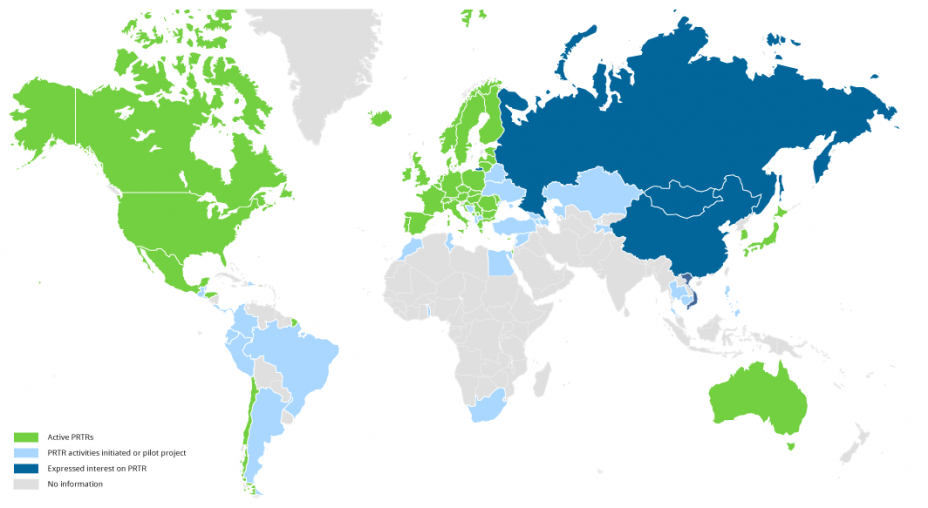TRI Around the World
In 1986, with the enactment of the Emergency Planning and Community Right-to-Know Act (EPCRA), the TRI was established as the first national Pollutant Release and Transfer Register (PRTR) in the world. Since then, environmental agencies in other countries have implemented their own right-to-know PRTR programs modeled after the TRI program. Currently, at least 50 countries have fully established PRTRs or have implemented pilot programs, as shown in the map below. More countries are expected to develop PRTRs in the future, particularly in Asia, South America, and Africa.
 Source: United Nations Economic Commission for Europe PRTR Global Map
Source: United Nations Economic Commission for Europe PRTR Global Map
As global PRTR implementation continues to grow, the TRI Program will continue to work with international organizations to:
- Assist in the development of new PRTR programs,
- Promote data standards and core data elements for greater PRTR comparability and harmonization, resulting in better global scale analysis capabilities, and
- Showcase PRTR data utility for assessing progress towards sustainability.
As an example, the TRI Program is currently working with the Organization for Economic Co-operation and Development (OECD) Exit on a project to use global PRTR data to assess progress toward the Sustainable Development Goals established in the United Nations' 2030 Agenda for Sustainable Development Exit, as described in the Project Spotlight below. For information on international PRTR activities, projects and partners, see TRI’s International webpage.
International Project Spotlight: Using PRTR Data to Assess Progress toward the U.N. Sustainable Development Goals
SDG Target 12.4
By 2020, achieve the environmentally sound management of chemicals and all wastes throughout their life cycle, in accordance with agreed international frameworks, and significantly reduce their release to air, water and soil in order to minimize their adverse impacts on human health and the environment.
Background. The TRI Program is collaborating on an OECD project to use global PRTR data to assess progress toward the United Nations’ (U.N.) Sustainable Development Goals (SDGs) Exit. These goals are designed to “shift the world on to a sustainable and resilient path” by setting targets that encompass the economic, environmental, and social dimensions of sustainability. As stakeholders act toward achieving the SDGs, the U.N. will measure progress toward the Goals using existing data where possible. One such existing data source for some of the SDGs may be found in countries’ PRTR data.
Project Focus. The U.N. SDG Target 12.4 Exit was identified as the target most directly relevant to PRTR data and is the focus of this initial phase of the project. This target focuses on reducing chemical releases to the environment.
Project Status. Global analyses of PRTR data are currently underway based on aggregated data for multiple chemicals from multiple countries in order to provide insight into progress toward achieving SDG Target 12.4. The figure below shows the trend for air and water releases of 14 pollutants from manufacturing facilities as reported to the 7 PRTRs analyzed in the project.
Next steps. As the project progresses and the methods and metrics are reviewed and refined, the findings may be included in the next update of the U.N. Sustainable Development Goals Report Exit.
Change in releases of 14 pollutants, 2008 to 2017 (kg)

PRTRs included in the analyses: Australia – National Pollutant Inventory (NPI), Canada – National Pollutant Release Inventory (NPRI), Chile – Registro de Emisiones y Transferencia de Contaminantes (RETC), European Union – European Pollutant Release and Transfer Register (E-PRTR), Japan Pollutant Release and Transfer Register (PRTR), Mexico – Registro de Emisiones y Transferencia de Contaminantes (RETC), United States – Toxics Release Inventory (TRI).
Chemicals included in the analyses: 1,2-Dichloroethane, Benzene, Cadmium, Chromium, Di-(2-ethylhexyl) phthalate, Dichloromethane, Ethylbenzene, Mercury, Nickel, Particulate matter, Styrene, Sulfur oxides, Tetrachloroethylene, Trichloroethylene.
Read more about the TRI Around the World.
This page was published in January 2021 and uses the 2019 TRI National Analysis dataset made public in TRI Explorer in October 2020.
